| Hardy Fern |
Conditions |
Height |
Zones |
Comments |
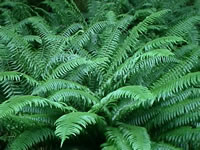 |
Western Sword Fern
Polystichum munitum |
Evergreen Fern
  
  
 |
3-5 ft. |
5-9 |
Native to the coastal forests of North America, this large, easy to grow fern grows best when planted in compost rich soil in a cool, shady, moist garden location. Western Sword Ferns are deer resistant and suitable for growing in the acidic soil found beneath Cedar Trees and other conifers. |
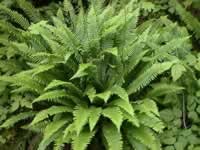 |
Deer Fern
Blechnum spicant |
Evergreen Fern
 
  |
12-24" |
7-9 |
Deer Ferns can be grown in difficult situations such as under evergreen trees or in deep shade. They are drought tolerate but will grow best if kept damp. Deer Ferns should be planted in a rich acidic (pH 5.0-6.5) soil.
They prefer full shade but will grow in almost any light conditions except full sun in a hot climate. Deer Ferns do not grow well in areas with hot humid summers.
How to Grow and Care for Deer Ferns |
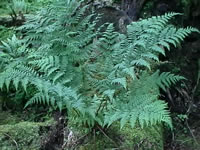 |
Coastal Wood Fern
Dryopteris arguta |
Deciduous Fern
  
  |
18-24" |
4-8 |
The Coastal Wood Fern is a common native to coastal regions from southern California to British Columbia. The lacy fronds fan out from thick reddish stems. Coastal Wood Ferns can be grown in most average garden soils as long as it is well draining. They grow best in partial or full shade, but can be grown in full sun if they are kept moist. |
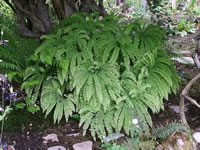 |
Pacific Maidenhair Fern
Adiantum pedatum |
Deciduous Fern
 
  |
18-24" |
3-8 |
The Pacific Maidenhair Fern can add a bit of graceful elegance to any partial to fully shaded area of your garden. The fronds emerge in early spring on black, wire-like stems that reach 18-24 inches. Your Pacific Maidenhair should be planted in a rich, humus soil and provided with constant, even moisture.
How to grow and care for Pacific Maidenhair Ferns |
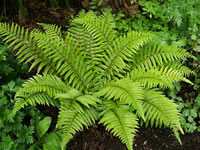 |
Tassle Fern
Polystichum polyblepharum |
Evergreen Fern
 
  |
18-24" |
5-8 |
Tassle Ferns are very showy and easy to grow. Their dark green fronds grow in a very symmetrical, rosette form. The stiff stems are covered with soft, copper-brown hairs. Tassle Ferns should be planted in compost rich, evenly moist soil in a area with partial to full shade. |
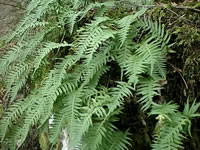 |
Licorice Fern
Polypodium glycyrrhiza |
Evergreen Fern
  
   |
12-18" |
5-9 |
Licorice Ferns are attractive, epiphytic plants that are primarily found growing with mosses on rotting logs or in Bigleaf Maple trees. They are fairly difficult to grow without a rotting log to plant them in. Licorice Ferns grow best partial to full shade, but will tolerate very short periods of bright sun. Generally they require moist soil, but they will tolerate brief periods of drought. |
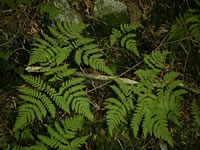 |
Oak Fern
Gymnocarpium dryopteris |
Deciduous Fern
 
  |
5-12" |
3-9 |
Oak Ferns spread by non-aggressive, underground rhizomes forming a nice delicate looking ground cover in your woodland setting. Oak ferns should be grown in evenly moist, compost rich soil and planted where it will grow in partial to full shade. |
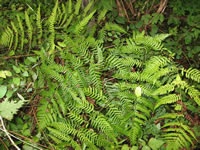 |
Autumn Fern
Dryopteris erythrosora |
Evergreen Fern
 
  |
15-24" |
5-9 |
The fronds of the Autumn Fern begin to emerge in early spring as a copper to reddish color and mature to dark green by mid summer. In the fall months, Autumn Ferns once again change colors. They should be planted in evenly moist, compost rich soil and grown where they will receive partial to full shade. Autumn Ferns are deciduous in frost zones. |
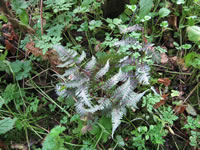 |
Japanese Painted Fern
Athyrium niponicum 'Pictum' |
Deciduous Fern
 
  |
12-15" |
4-8 |
The slow spreading Japanese Painted Fern is probably the most decorative of all ferns. The fronds are tri-colored blends of silver, pink and green, standing above burgundy stems. Japanese Painted Ferns should be grown in full shade to partial shade, where soil is moist but well-drained. |
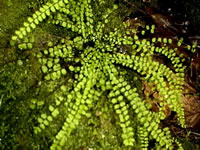 |
Maidenhair Spleenwort
Asplenium trichomanes |
Evergreen Fern
  
  |
4-7" |
3-9 |
The Maidenhair Spleenwort is a rhizomous, low growing, creeping fern that forms dense tufted rosettes of deep green fronds on black, wire-like stems. In nature, Maidenhair Spleenworts grow in shady rock cervices and rocky, calcium rich (limestone) soil. They require constant moisture and good drainage. |
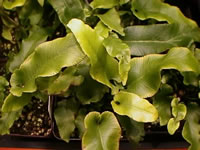 |
Hart's Tongue Fern
Asplenium scolopendrium |
Evergreen Fern
  
  |
24-30" |
6-8 |
Unlike most other ferns, tropical looking Hart's Tongue Fern has strap-like undivided fronds. These glossy green ferns are native to most areas of the world with alkaline soil. In areas with acidic soil, you will have to to add lime to the soil before planting. Keep the soil evenly moist. Hart's Tongue Ferns are well suited for growing as a container plant, as long as you add extra lime to the soil mix. |